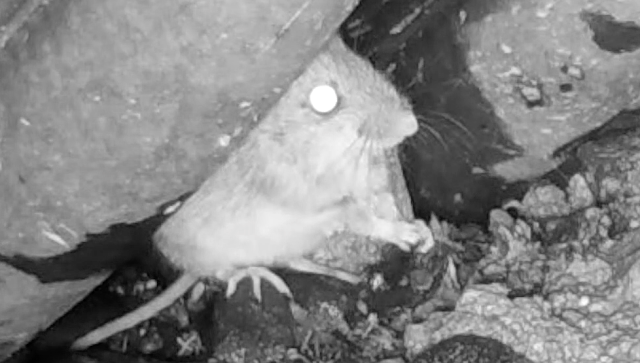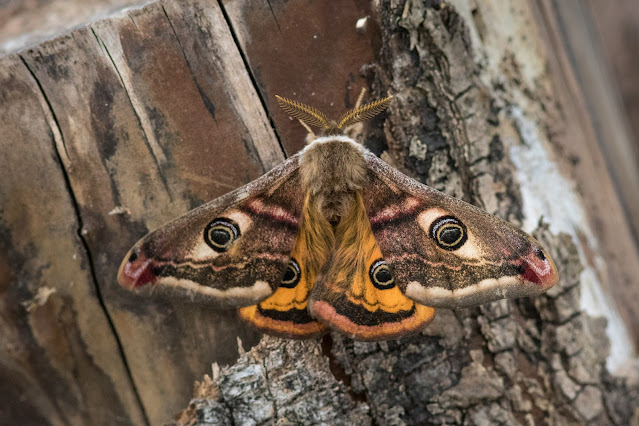After the wood mouse, this is another animal that has shown up while the trail camera is watching the water shrew. Water rails are shy birds, preferring to stay in cover in or around the water's edge. This one was unaware of the camera and was searching for food. It didn't find the water shrew's larder, or perhaps the larder was empty.
My Blog List
Friday 27 May 2022
Monday 23 May 2022
Fox News - Stop Press
On the previous two nights a fox has turned up within a minute of me putting out the peanuts, first time a yearling and then the dog fox. Last night, hoping for a repeat I opened the back door early, about 9.10, when it was still light, and a fox was by the meadow pond only about 15m away. It saw and heard me and trotted away to the far side of the meadow where it stood watching me from about 30m. Then suddenly it darted back the way it had gone, about 5m, and caught something. It stood looking at me while crushing something in its jaws. I grabbed a camera and when I returned it was trotting across the meadow. I fired off about four shots but only one was even vaguely in focus. It shows the fox with an early dinner of fresh rabbit, caught right in front of me.
I couldn't see which fox this was. The first to turn up for peanuts was the dog, about half an hour later. We'll see what happens tonight.
Wednesday 18 May 2022
Fox News
The foxes are here for their dinner every night between 9.30 and 10.00. The alpha pair are very regular visitors and some of last year's cubs are still in the family. The vixen has shown less sign that she is feeding this year's cubs in recent days which I think must mean that they are mostly weaned. Unlike her mate, she often sits down while she is feeding. These two photos, taken three weeks apart, show that the lawn has started to grow after a cold dry spring.
Thursday 12 May 2022
Raiding the water shrew's larder
The water shrew's whole world is a bit of muddy bank under the culvert and a few metres in either direction. It is amazing to see how much it can find to eat very close by. The shrew seems to favour one spot under the culvert to eat (back left as we look at it). Sometimes it stays to eat (often with its back to the camera) but sometimes it seems to drop the food and leave to find more almost immediately. I came to the conclusion that it must be caching food there if it has a short-term surplus, and it doesn't seem to have any difficulty finding food. Then I found a paper from Austria* which describes food caches in the Eurasian water shrew, mainly consisting of caddis fly larvae and water snails. I presume the venomous bite of the water shrew will disable the prey to stop it escaping. Here is the shrew eating, first a shrimp it has just brought in, and then what looks like a larva, perhaps caddis fly, from the larder.
This water shrew first came to notice when the camera was set to record otters. Now several other things have turned up while the camera is after the water shrew. The most intriguing has been a wood mouse. Several times the camera has seen a wood mouse come to the cache and take food, either eating it on the spot or taking it away. As far as I can see it is always a caddis fly larva still in its case. The next video shows the shrew depositing food without eating it, then once coming from the nest/burrow for a snack, and then the mouse - twice it comes to take a caddis fly away and the third time it stays to eat it. I have added a short slow-motion replay to show the mouse biting the end off the casing and pulling out the larva, just like the shrew does.
The camera is still in place in the hope that it will record even more interesting behaviour.
* Haberl W. Food storage, prey remains and notes on occasional vertebrates in the diet of the Eurasian water shrew, Neomys fodiens. Folia Zool. 51(2):93-102 (2002).
Friday 6 May 2022
The emperor moth
I think this is quite the most beautiful British moth. This is a male emperor moth, Saturnia pavonia. It flies in late spring and lives in upland areas. Males can be enticed into view using a pheromone which mimics the scent of a female. The males fly in the daytime but the females are said to fly only at night. I wonder if the females attract males for mating by day but then feed and lay eggs at night.
Just over a week ago I took the pheromone lure, hidden behind the bark of a small log, to Simonside near Rothbury, where I had first seen an emperor last year but this time there was no response. I moved round to Harwood Forest and within a few minutes a moth appeared. It flew around incessantly, only pausing for a fraction of a second, so this photo was the best I could do.
On Sunday I went back to Muggleswick in County Durham, which yielded the best photos last year but again drew a blank. A few miles further south I tried again on the Waskerley Way and a moth arrived within ten minutes. A few minutes later there were six, all zooming round looking for the non-existent female. They fly manically so the photography is challenging. Nearly all the photos are out of focus, or motion-blurred, or miss half the moth, or don't include a moth at all. Here are a few that turned out OK.
This was the only time I had two in the frame together.
This male discovered the lure and realised it was a con.
The others also disappeared after a few minutes so I moved a few miles west to Horseshoe Hill. There another four moths arrived to investigate so this seems to be a pretty good area for them.
One of these moths was a bit tatty and looked rather tired with all its exertions and it flopped down onto the grass for a rest so I could even get a photo with the phone.
I had taken great care not to get any trace of pheromone on me or my hands but it did accept the offer of a lift onto my hand for a photo.
My next challenge will be to find and photograph a female emperor but that won't be so easy.
Tuesday 3 May 2022
A rare garden visitor
While I was on the phone yesterday afternoon I glanced out of the window and saw a bird I didn't immediately recognise. I peered at it for a few seconds but then all the birds were spooked by something and flew off. It was larger than a bullfinch with a pale beige front and a neat black bib but it was looking straight towards me so that is as much as I could see. I wondered about a hawfinch or possibly a waxwing, although a waxwing wouldn't come near a feeder. During the rest of the phone call and the rest of the afternoon it didn't return so I thought I would never know what it was.
Then first thing this morning it was back. And it was a hawfinch. As always, there was camera close at hand so this time I was able to take a photo.
I even had time to change to a camera with a longer lens to get some slightly less grainy photos.
Hawfinches are scarce birds and rare garden visitors. A few years ago I spent two days wandering around fields near Morpeth, a few miles north of here, to get some rather distant views and then this one turns up almost on my doorstep. What a treat.
I don't keep a formal garden list but it would now include yellowhammer, waxwing, red-backed shrike, oystercatcher, buzzard, woodcock, ring-necked parakeet - and hawfinch. I wonder what will turn up next.







































